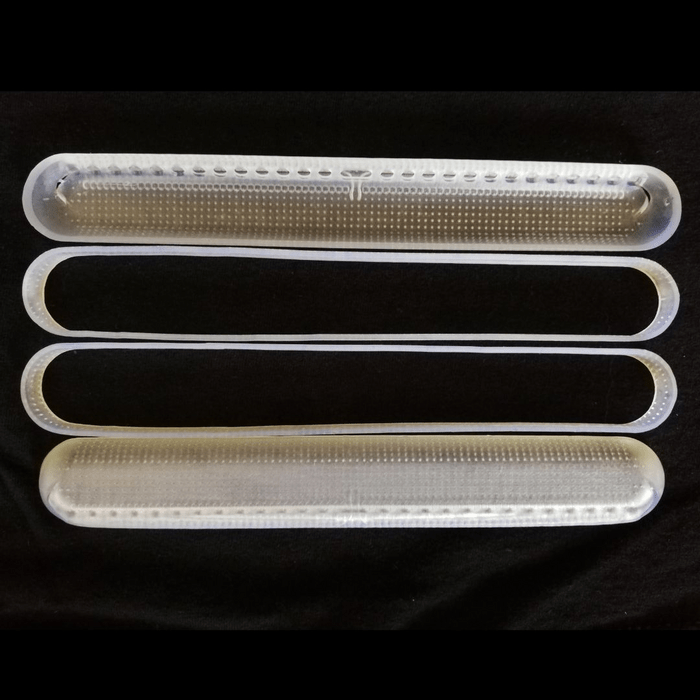WASHINGTON — A new study has revealed how the glass-like shells of diatoms help these microscopic organisms perform photosynthesis in dim conditions. A better understanding of how these phytoplankton harvest and interact with light could lead to improved solar cells, sensing devices and optical components.
“The computational model and toolkit we developed could pave the way toward mass-manufacturable, sustainable optical devices and more efficient light harvesting tools that are based on diatom shells,” said research team member Santiago Bernal from McGill University in Canada. “This could be used for biomimetic devices for sensing, new telecommunications technologies or affordable ways to make clean energy.”
Diatoms are single-celled organisms found in most bodies of water. Their shells are covered in holes that respond to light differently depending on their size, spacing and configuration. In the journal Optical Materials Express, the researchers, led by McGill University’s David V. Plant and Mark Andrews, report the first optical study of an entire diatom shell. They analyzed how different sections of the shell, or frustule, respond to sunlight and how this response is connected to photosynthesis.
“Based on our findings, we estimate that the frustule can contribute a 9.83 percent boost to photosynthesis, especially during transitions from high to low sunlight,” said Yannick D’Mello, first author of the paper. “Our model is the first to explain the optical behavior of the entire frustule. So, it contributes to the hypothesis that the frustule enhances photosynthesis in diatoms.”
Combining microscopy and simulation
Diatoms have evolved for millions of years to survive in any aquatic environment. This includes their shell, which is composed of many regions that work together to harvest sunlight. To study the optical response of diatom frustules, the researchers combined computer optical simulations with several microscopy techniques.
The researchers began by imaging the architecture of the frustule using four high-resolution microscopy techniques: scanning near-field optical microscopy, atomic force microscopy, scanning electron microscopy and dark field microscopy. They then used these images to inform a series of models that the researchers built to analyze each part of the frustule via 3D simulations.
Using these simulations, the researchers examined how different colors of sunlight interacted with the structures and identified three primary solar harvesting mechanisms: capture, redistribution and retention. This approach allowed them to combine the different optical aspects of the frustule and show how they work together to aid photosynthesis.
“We used different simulations and microscopy techniques to examine each component separately,” said D’Mello. “We then used that data to build a study of how light interacts with the structure, from the moment it gets captured, to where it gets distributed after that, how long it is retained, and until the moment it likely gets absorbed by the cell.”
Boosting photosynthesis
The study revealed that the wavelengths with which the shell interacted coincided with those absorbed during photosynthesis, suggesting it could have evolved to help capture sunlight. The researchers also found that different regions of the frustule could redistribute light to be absorbed across the cell. This suggests that the shell evolved to maximize the exposure of the cell to ambient light. Their findings also indicated that the light circulates inside the frustule long enough to aid photosynthesis during periods of transition from high to low illumination.
The new frustule model could make it possible to cultivate diatom species that harvest light at different wavelengths, allowing them to be customized for specific applications. “These light harvesting mechanisms of diatoms could be used to improve the absorption of solar panels by allowing sunlight to be collected at more angles, therefore partially removing the dependency of the panel to directly face the sun,” said Bernal.
The researchers are now working to refine their model and plan to apply their new toolkit to study other species of diatoms. After that, they plan to extend the model beyond the light interactions within a single frustule to examine behaviors between multiple frustules.
This work commemorates Dan Petrescu, who passed away last year. The research would not have been possible without his insights, assistance and dedication.
Paper: Y. D’Mello, S. Bernal, D. Petrescu, J. Skoric, M. Andrews, D. V. Plant, “Solar energy harvesting mechanisms of the frustules of Nitzschia filiformis diatoms,” Opt. Mater. Express 12, 12, pp. 4665-4681 (2022).
DOI: https://doi.org/10.1364/OME.473109
About Optical Materials Express
Optical Materials Express is an open-access journal focusing on the synthesis, processing and characterization of materials for applications in optics and photonics. It is published by Optica Publishing Group and emphasizes advances in novel optical materials, their properties, modeling, synthesis and fabrication techniques; how such materials contribute to novel optical behavior; and how they enable new or improved optical devices. The Editor-in-Chief is Andrea Alù from City University of New York, USA. For more information. For more information, visit Optical Materials Express.
About Optica Publishing Group (formerly OSA)
Optica Publishing Group is a division of Optica (formerly OSA), Advancing Optics and Photonics Worldwide. It publishes the largest collection of peer-reviewed content in optics and photonics, including 18 prestigious journals, the society’s flagship member magazine, and papers from more than 835 conferences, including 6,500+ associated videos. With over 400,000 journal articles, conference papers and videos to search, discover and access, Optica Publishing Group represents the full range of research in the field from around the globe.
Journal
Optical Materials Express
DOI
10.1364/OME.473109
Article Title
Solar energy harvesting mechanisms of the frustules of Nitzschia filiformis diatoms
Article Publication Date
22-Nov-2022

















